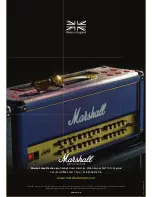
First and foremost, thanks for getting
my new Marshall Signature Amp – it’s
something I’m very proud of. Having a
Signature Marshall is an elite fraternity
and I feel honored to be part of it.
When I look across at the names of the
guys who’ve got and have had signature
models it’s very impressive to say the
least. They’re all players I greatly respect
and listen to. The amps that bear their
names are very cool and I like the fact
that they’re specifi c, they do something
outrageous and when you plug in to one
you get really inspired. So, for all those
reasons it’s really an honor to be part of
the group.
As you may know I’m not new to Marshall – we
have quite a history together. Back in 1988, when
I started touring for “Surfi ng With The Alien” I
was taking out the old Marshall heads I’d recorded
with and then somewhere along the line the guys
at Marshall started lending me gear in different
territories which was really nice of them because
we were touring with such a shoe-string budget! I
wound up playing though a whole lot of different
ones and eventually, by the end of that tour, I’d
realized that using a distortion box into a clean
channel was really helping me do the show. At the
end of the tour I went back into the studio to
start recording what would become “The Extremist”
album, and Marshall had sent over this new head –
the 30th Anniversary 6100. The fi rst thing I did was
go in to the clean channel and seeing how my box
sounded and it was like: Wow – that’s amazing.. And
that was really the beginning of me just depending
on that head. I’ve got 5 of them & I even have a
full stack with the polished brass chassis and logo
that’s very cool.
I played “hooky” from the brand for while but
when Chickenfoot formed a few years ago, I came
back to Marshall because I was looking for a
bigger, more organic, more complete sound. The
great thing about a distortion box into a clean
channel is that if you’re playing melodies and solos
back-to-back, when you put it in-front of everyone
else in the band, it creates the illusion that it’s the
biggest, loudest thing. But, if you’re playing through
a rig like that and you’ve got a very dynamic drummer
like Chad Smith, a bassist like Michael Anthony and
a vocal powerhouse like Sammy Hagar, you quickly
fi nd out that your sound really isn’t that big and
dynamic at all – it’s smaller!
So, before the fi rst proper Chickenfoot tour, we
did a couple of warm-up runs in small clubs.
Sammy (Hagar) was playing through his old rig and
I was playing through mine and we both realized
that our amps weren’t up to it. So we contacted
Marshall about helping us out for the subsequent
“real” tour as neither of us had confi dence in our
rigs. Marshall set us up with some JVM and some
Vintage Modern heads and we just loved them. They
literally transformed the sound of the band. I was
using a JVM and the end of that touring cycle I’d
realized exactly what it was I was looking to get
out of the amp. Then came the offer to work with
Marshall on a signature head…
I was not only fl attered by this gesture but also
very excited because I had real, practical experience
with the JVM and I had some things I wanted
to change about it – specifi cally, make an already
great amp even bigger, bolder, more punchy and more
dynamic. To me the JVM410H’s four channels were
amazing but what was even more mind-blowing was
that it had three switchable modes per channel. So
it wasn’t merely a 4 channel amp, it was 4 by 3. It
was fascinating just to sit there and play through
it. I felt that the designer, Santiago Alvarez, had
really made a huge step forward in amplifi er design
by being able to pack so much into a head while
making it so elegantly designed and functional. This
amp gets you in and out of all the different eras of
rock music, no questions asked.
So that’s how myself and Santiago started working
on the JVM410HJS. I think you can hear a good
example of how Chickenfoot’s sound blossomed
as a result of the JVM on the “Get Your Buzz On”
live DVD [fi lmed on one night in 2009]. It’s a very
fat, rich tone which we’ve since taken several steps
further to make it even more of an organic rock and
roll sound - which is the hallmark of my signature
amp.
Thanks to a really long and fruitful R&D period,
I’ve been able to record, rehearse and play live with
all the prototypes while Santiago and I fi ne tuned
the amp…not just with Chickenfoot but on my
solo stuff too. I’ve really put all the prototypes
through their paces in “the real world” – well, in
“my real world” anyway. To my mind, the original
JVM410H has a sizeable chunk of Marshall History
encapsulated within its 12 modes. I feel that
Santiago and myself have capitalized and expanded
upon that fi rm sonic foundation and, as a result,
the JVM410HJS contains a lot of classic Marshall
tones as well as a few fresh ones that people will
regard as new classics.
I sincerely hope JVM410HJS gives you as much
playing pleasure as it gives me. I can honestly say
that I’ve never had this much fun or derived this
much inspiration from an amp before. Enjoy!
Joe Satriani
E
N
G
LI
S
H
3
2
Summary of Contents for JVM410HJS Joe Satriani
Page 1: ......




























